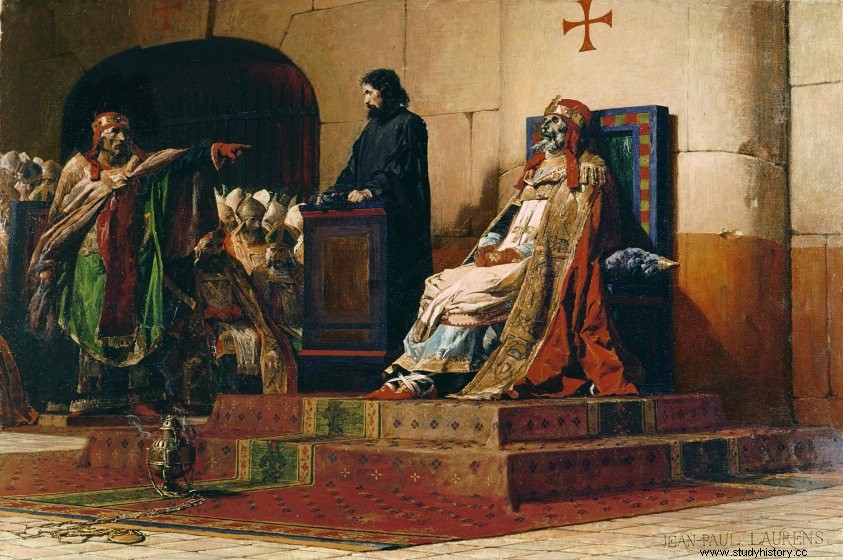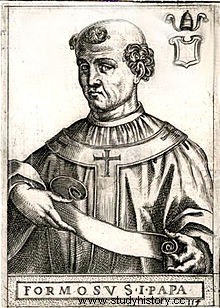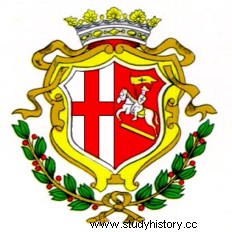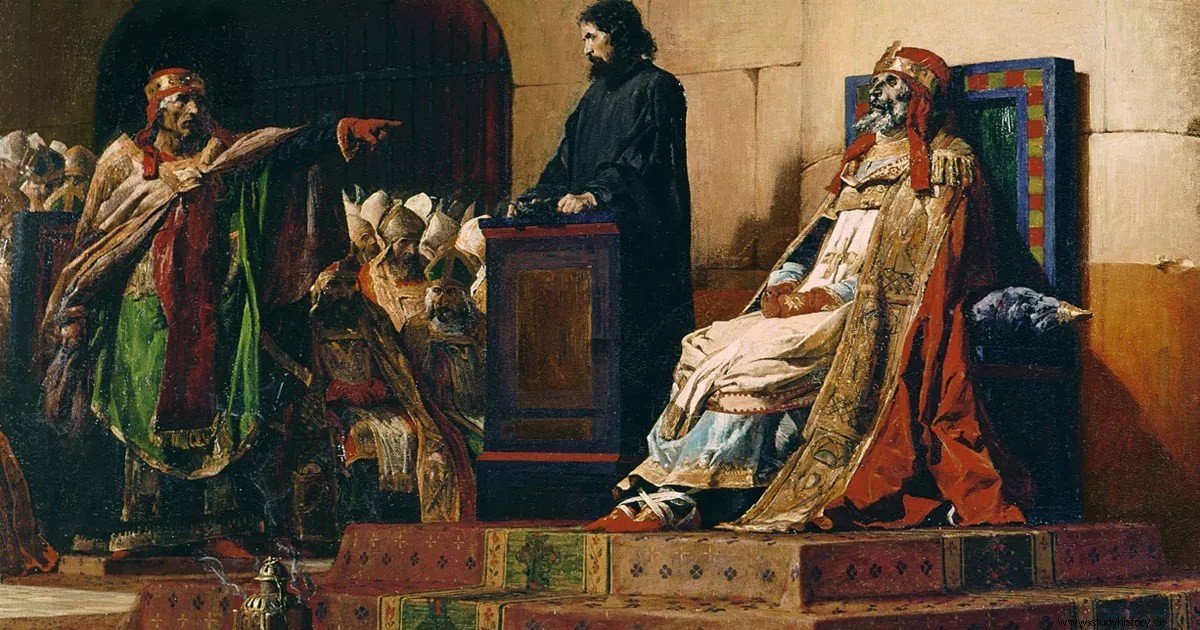
Beginning of the ecclesiastical career
Born in Rome in the middle of the Middle Ages, around the year 816 , from father Leone and unknown mother, Formoso he immediately undertook a training closely linked to the ecclesiastical world in the place where he was born and lived throughout his life. We know with certainty, thanks to the attestation of various documents, that around 846 he was canon regular, and more precisely he was consecrated bishop of Porto by the pontiff of the time, Niccolò I Magno, to then receive the appointment of cardinal. His uncompromising and rigorous lifestyle guaranteed him from the early years of his ecclesiastical career the approval of both Nicholas I and Hadrian II, his successor in the papal office. He was also an admired and prominent figure in the ecclesiastical world for his numerous intellectual gifts; in fact being a great scholar he knew both Greek and Latin.
Also known for its numerous diplomatic missions, Formoso is best remembered for persuading Charles the Bald to be crowned sovereign of France by the pope between 869 and 872 ; moreover, King Boris I was so satisfied with the ecclesiastical intervention of Formosus in Bulgaria between 866 and 867 to be requested from two popes, Niccolò I and Adriano II then, to appoint him metropolitan archbishop of Bulgaria, something that both popes could not do since the transfer of a bishop to a seat other than their own was prohibited. This denial by the pontiffs greatly exacerbated apostolic relations with the Bulgarian Church, prompting Boris I to bring it back under the authority of the Patriarch of Constantinople, as it was in the past, thus destroying all the commitment and hard work of Formosus to bring it back together. the Bulgarian to the Roman Church.
The pontificate
Already several years before his official papal election, Formoso had been a candidate for the papal throne following the death of Hadrian II in 872 ; although his supporters were many, he preferred to opt for the archdeacon John VIII, one of the leading exponents of the "pro-French" current and therefore in favor of the western Carolingians (including Charles the Bald and Charles the Fat). Formoso instead represented the opposition, or the "pro-German" party (in favor of the Eastern Carolingians), which cost him the accusation of conspiracy against the state forcing him to flee from Rome with some supporters in 876 . However shortly after John called a council in the Pantheon, forcing Formosus to return to the capital with the threat of excommunication, which was only implemented later in a second council against him and against all those who were with him. It was only thanks to John's successor, Marino I, a pontiff with a peacemaking soul and also "pro-German", that the excommunication was dissolved in Formosus and all the members accused with him of the conspiracy. He was also reconfirmed the office of bishop of Porto in 883 .
On the death of his predecessor, Pope Stephen V, protagonist of the strong political unrest that arose due to the deposition of Charles the Fat, thus opening the way to the dominion of the great patrician families over Rome, which took place in 891 for natural reasons, a short time later (precisely on October 6) Formosus was elected as the 111th pope of the Church of Rome unanimously by the clergy. Not only the clemency of Marino I participated in this election, but also the "pro-Germanic" faith of his immediate successors, Adriano III and Stefano V. Nevertheless, support did not come only from the ecclesiastical faction; Arnulf of Carinthia, ruler of the eastern part of the Franks (Germanic), and his protege Berengario, Marquis of Friuli, also supported Formosus and were also in excellent correspondence with him.

However, we are talking about a very troubled era, in which the papal election did not represent exclusively a "ritual" between cardinals, but rather embodied a real battle for the division of the territory of the Church in the Vatican State. Therefore all those who had the support of the pope, who was by now acquiring and steadily consolidating the universality of his powers over all the sovereigns of Europe thanks to a long and gradual process (which will last for centuries), could count on enormous moral and spiritual support from the ecclesiastical side, as well as a great military and political support together with a consistent force of persuasion that he could exercise on all his enemies. All this was possible only thanks to the immense power that the pontiff was consolidating through a capillary system of taxation, imperial concessions, privileges and territorial rights over which he claimed undisputed authority.
The precarious Italian situation
It was precisely within the stormy events of this tumultuous historical period that even Pope Formosus himself was involved. The Empire was in fact "split" between the "pro-German" and the "pro-French", and the latter, despite having been sidelined thanks to the "pro-German" majority who supported the pontiff, had no intention of surrendering tolerating the winning faction in power. However, the conditions of the Church of Rome were very precarious and unstable, since due to the distance from the Roman territory of the sovereign Arnolfo and his protege Berengar (who were in Germany), the pope's greatest supporters, Formosus was forced to entrust all his security exclusively in the hands of the Duke of Spoleto. The situation degenerated when, approximately in 893 , the pontiff found himself forced to renew the imperial coronation of Guido II of Spoleto. This event was dramatic for the territories of the Church since Guido, now absolute possessor of imperial power, exploited his authority in an excessive way, raiding and plundering the ecclesiastical territories with impunity.

Rome had thus fallen into a picture of uncertainty, and the civil war was inevitably at the gates since such disorders would not be tolerated for much longer. Formoso, forced to resort to extreme measures in order to intervene, towards the end of 893 he sent messengers to Arnolfo's court begging him, as the one and only legitimate emperor, to free Italy from the so-called "bad Christians" who were destroying it. Not even a year later, at the beginning of 894 , Arnolfo crossed the Alps and, although he seemed ready for a direct attack against the Spoleto, his was only a great "entrance on the scene" (a sort of "demonstrative action") to earn the respectful and submissive homage of the princes of Italy north-central. Convinced that all this could be sufficient to quell the riots, Arnolfo then returned to his homeland, thus leaving Guido to return to carry out all the injustices he had begun.
However, towards the end of the year 894 , Guido died struck by a sudden malaise, leaving his son Lamberto II alone with his mother Ageltrude, a bitter enemy of the “pro-Germanic” faction. Obviously Lambert immediately claimed the imperial crown of his father, and wanted to be crowned emperor in Rome with the highest honors of him. Despite the numerous attempts by Pope Formosus to take as much time as possible and thus avoid the inevitable event, he eventually found himself forced by circumstances and proceeded to the coronation. A few months later, however, in 895 , Arnolfo crossed the Alps again, this time determined to take back his legitimate title of king of Italy, thus pushing the Spoleto people to swear eternal hatred to the pope for his betrayal, and incarcerating him in Castel Sant'Angelo after having strategically incited the plebs Roman against the pontiff.
In an unsustainable climate of revolt, Lamberto barricaded himself in Spoleto ready to fight, waiting for Arnolfo's imminent arrival, while his mother Ageltrude continued to stir up the people and especially the Spoleto people towards the forthcoming revolt. However, she found herself forced to surrender, as Arnolfo's troops had the upper hand, and she had to return to Spoleto to hide. Pope Formoso was thus freed thanks to Arnolfo, who immediately began a decisive march towards Spoleto, ready to face Lamberto and his mother in the decisive battle. However, his journey was short; Arnolfo, shortly after being crowned again emperor by Formosus, was struck by a severe paralysis that forced him to quickly return to Germany, where he died shortly after (in 899 ) leaving "free field" to his opponent Lamberto for only a year, when he too died suddenly breaking his neck after a bad fall from his horse during a hunting trip.
Death and the "synod of the corpse"
Formoso, now over eighty, died a few years before the end of these war events that struck Italy in that period, on April 4th of 896 . It therefore seems almost obvious to say that death saved him from the otherwise inevitable reprisals of his adversaries. However, we do not know whether it is a natural death, probably due to advanced age, or a premeditated poisoning by his numerous enemies. He was eventually buried in the Vatican precincts, where he remained there for less than a year (only 9 months) before he was exhumed and subjected to a harsh post-mortem process. .
What happened next to the corpse of Pope Formosus is unbelievable; about a year after his death, in 897 , the Spoleto family, which continued to foment a very strong hatred towards the pontiff for having been denied by the pope and for having called a foreign sovereign to Italy with all his army in tow, imposed on the new pontiff they elected, Stephen VI (obviously not "pro-German"), to institute an elaborate post-mortem process towards Formosus, so that all the Roman ecclesiastical members condemned him as the only traitor to the homeland. This process will take the name of "synod of the corpse" or “cadaveric council” .

Therefore the corpse of Formosus was exhumed from his tomb in the Vatican, dressed and adorned with all the typical papal ornaments and placed on the royal papal throne in the Lateran Basilica. The trial then took place as any trial of the time would have taken place, and various accusations were brought against the now deceased pontiff, who would have had to answer to the current Pope Stephen who played the role of accuser. A deacon was also placed in defense of Formosus, very frightened by the occasion and with a useless function within the process already established. Obviously, Formoso could not respond to the accusations, some of which even dated back to those made years and years earlier by John VIII, this trial turned out to be more a "macabre little theater" than a concrete judicial act. The final verdict finally established that the late pope had been unworthy to hold the papal office, and therefore was deposed according to the official custom that would be used for someone alive; moreover, all that he had legislated in life and all of his acts and amendments were declared null and void.
The uniqueness of Formoso
The corpse was never reburied, all the typical vestments were ripped off him, the three fingers he used to perform blessings were cut off and among the general cries of a crowd in pure delirium, the corpse was thrown into the Tiber, where he remained there for about three days before running aground near Ostia, where he was found by a monk and hidden until Stephen VI was alive and in office. It was then returned to the new pontiff, Romano, towards the end of 897 , and placed among the tombs of the apostles with the accompaniment of a great and solemn ceremony in honor of him. The trial against him was eventually canceled and all the decisions made by Formosus in life were put into effect again.
That of Formoso is a unique case in all of medieval history and, although the same treatment was also applied to the corpse of Pope Boniface VIII , due to his bad conduct, his remains the one and only documented event of a real "corpse council". Although the validity of the process is obviously to be classified as nothing, it still had a great impact on the events of the time, especially for those who chose to carry out and organize it. The reactions to this episode were however very mixed, since if on the one hand many were in favor proclaiming a strong hatred of Formosus, another good part felt a great horror at this dismal execution. In conclusion, we can therefore say that this was a "horror process" in the Middle Ages, and a real revenge carried out in the Vatican.
